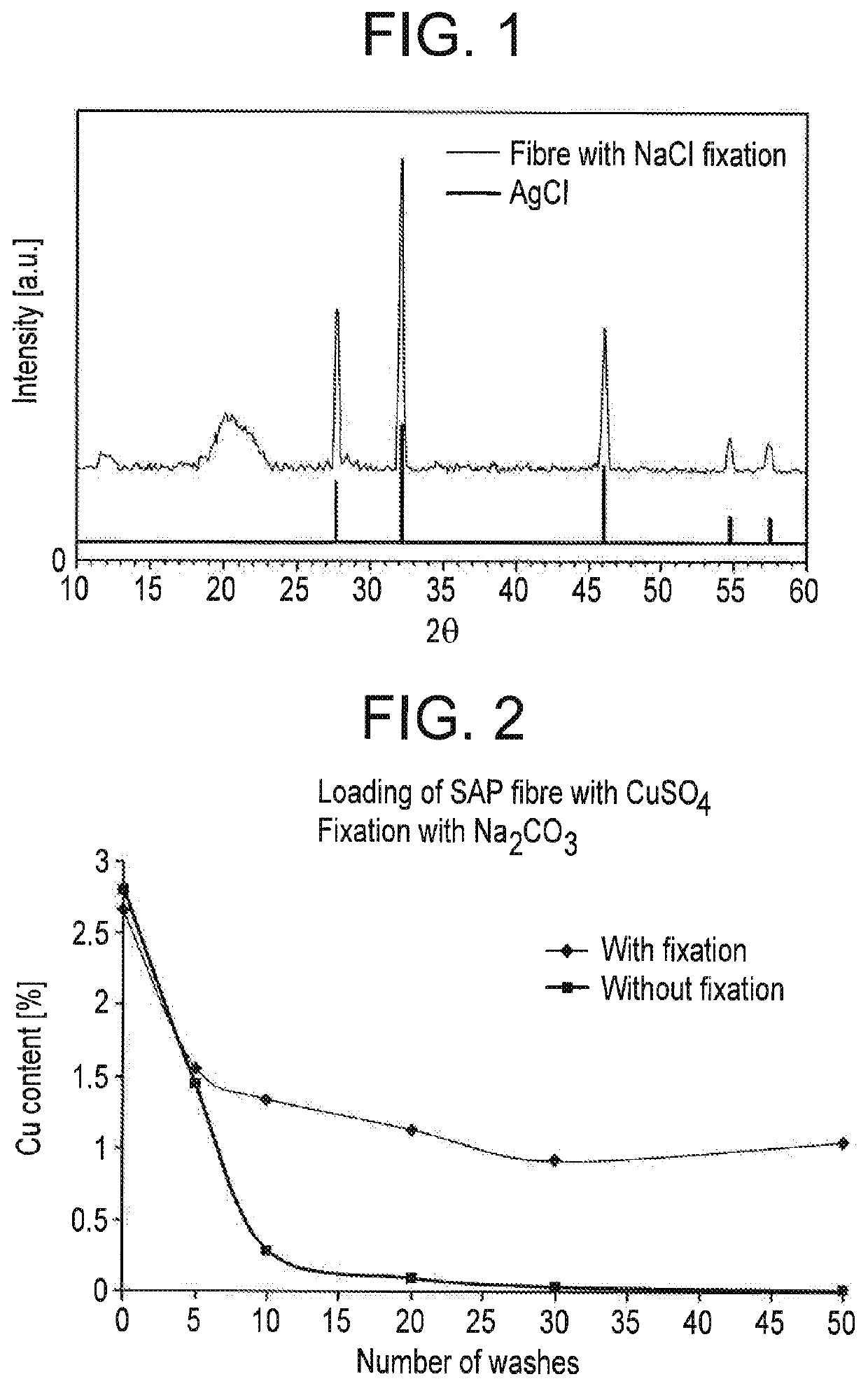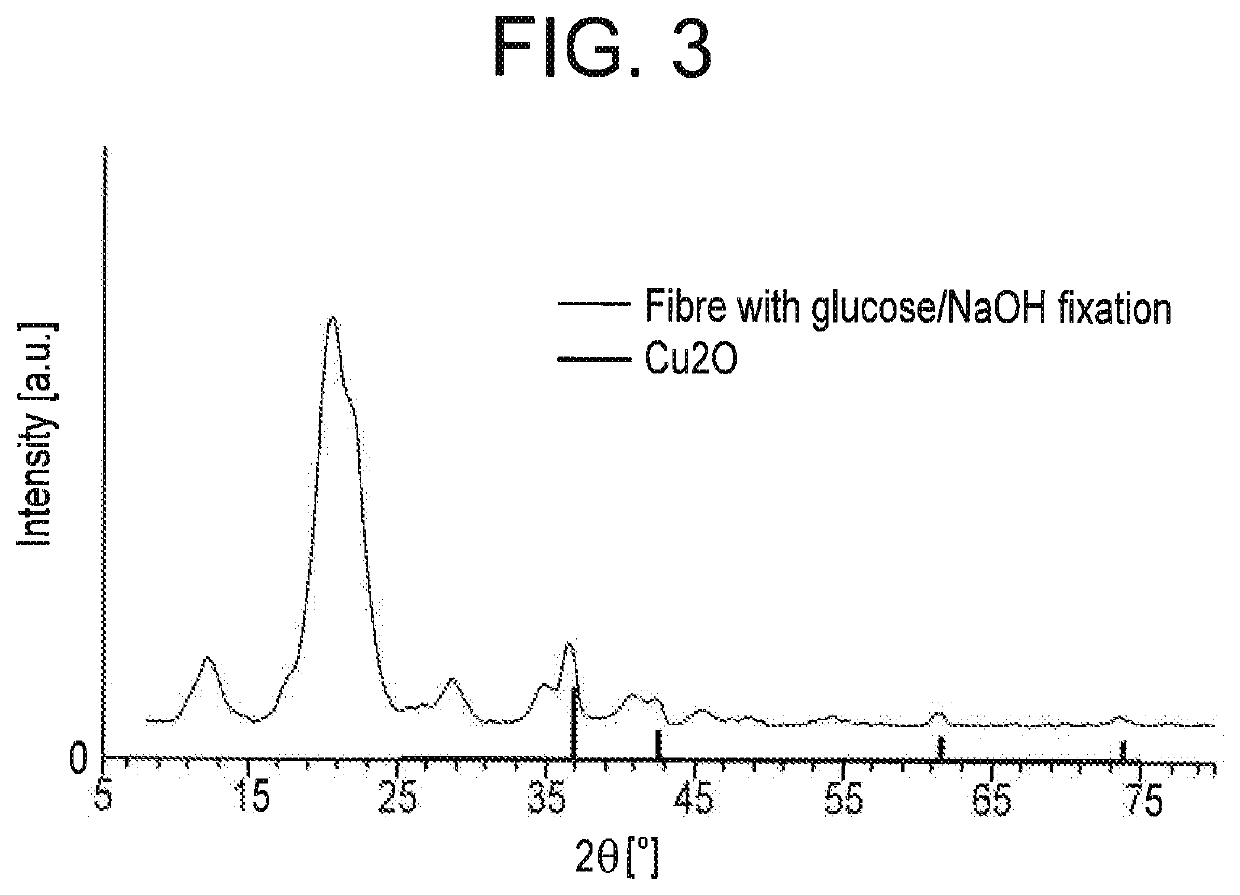Wash-resistant bioactive cellulose fibre having antibacterial and antiviral properties
a bioactive cellulose and antibacterial technology, applied in the direction of biocidal agent addition, application, bandages, etc., can solve the problems of high chemical intensity, complex procedure, and genetic disturbance, and achieve high absorption capacity and high absorption capacity
- Summary
- Abstract
- Description
- Claims
- Application Information
AI Technical Summary
Benefits of technology
Problems solved by technology
Method used
Image
Examples
example 1
[0049]The ion-exchange fibres, produced according to DE19917614 and containing a proportion of 15% sodium polyacrylate, are treated with a copper sulfate solution. To this end, 15 kg of the ion-exchange fibre are washed with deionized water and then loaded with a 0.15 M aqueous copper sulfate solution. After a residence time of 20 min in this solution with intensive stirring, the fibres are spun down and centrifuged. In a second treatment bath, the fibres are finished using a customary softener, for example AFILAN® RA, The fibres have a linear density of 6.7 dtex, an elongation of 10% and a breaking strength of 21 cN / tex. The copper concentration is 28 000 mg / kg copper. After 50 wash cycles, the fibres still contained 200 mg / kg copper. Measurement of the antibacterial effect versus Staphylococcus aureus showed a reduction of log 5.8 and, after 50 wash cycles, log 5.3; versus Klebsiella pneumoniae, there was a reduction of log 5.8 and, after 50 wash cycles, log 5.5. For both bacteria...
example 2
[0050]Ion-exchange fibres produced according to Example 1 are, following copper loading, additionally placed in a second immersion bath containing a 10 g / l sodium carbonate solution and stirred therein for 20 minutes. The fibres are then spun down and centrifuged. In a third treatment bath, the fibres are finished according to Example 1. The copper concentration is 26 500 mg / kg copper. After 50 wash cycles, the fibres still contained 10 400 mg / kg copper. Compared to the non-fixed fibre from Example 1, this corresponds to an increase in recovery after 50 washes from approx. 0.7 to approx. 39%.
example 3
[0051]Ion-exchange fibres produced according to Example 1 are, following copper loading, additionally placed in a second immersion bath containing a solution containing 10 g / l glucose and 5 g / l NaOH and stirred therein for 20 minutes. The fibres are then washed, spun down and centrifuged multiple times until a neutral reaction is achieved. In a third treatment bath, the fibres are finished according to Example 1. The copper concentration is 7890 mg / kg copper, After 50 wash cycles, the fibres still contained 321 mg / kg copper. The antibacterial effect after 50 wash cycles versus Staphylococcus aureus showed a reduction of log 4.7, and versus Klebsiella pneumoniae a reduction of log 4.4, The antiviral effect against Pseudomonas sp. DSM 21482 showed a log 4.5 reduction and, after 50 washes, still a reduction of log 4.1. This corresponds to strong antiviral activity even after 50 washes.
PUM
 Login to View More
Login to View More Abstract
Description
Claims
Application Information
 Login to View More
Login to View More - R&D
- Intellectual Property
- Life Sciences
- Materials
- Tech Scout
- Unparalleled Data Quality
- Higher Quality Content
- 60% Fewer Hallucinations
Browse by: Latest US Patents, China's latest patents, Technical Efficacy Thesaurus, Application Domain, Technology Topic, Popular Technical Reports.
© 2025 PatSnap. All rights reserved.Legal|Privacy policy|Modern Slavery Act Transparency Statement|Sitemap|About US| Contact US: help@patsnap.com


